Instructions for Side by Side Printing
- Print the notecards
- Fold each page in half along the solid vertical line
- Cut out the notecards by cutting along each horizontal dotted line
- Optional: Glue, tape or staple the ends of each notecard together
A&P chapter 6
front 1 Bones are constantly undergoing resorption for various reasons. Which of the following cells accomplishes this process?
| back 1 osteoclast |
front 2 The notable hardness of bone is attributed to ________.
| back 2 the presence of inorganic hydroxyapatites |
front 3 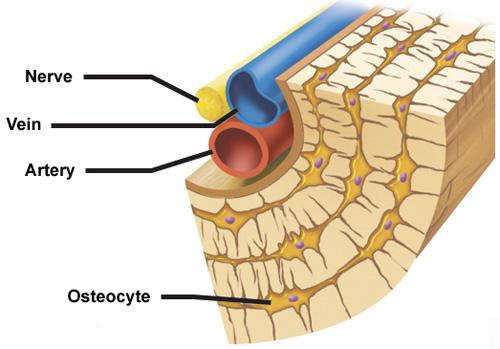 The indicated blood vessels and nerve are found within a ______.
| back 3 Central (Haversian) canal |
front 4 When should prevention of osteoporosis start?
| back 4 The prevention of osteoporosis should begin with children while bones are still growing. Children should increase their bone mass to provide additional protection from osteoporosis in the future. |
front 5 The term diploë refers to the ________.
| back 5 internal layer of spongy bone in flat bones |
front 6 Cartilage grows in two ways, appositional and interstitial. What is appositional growth?
| back 6 the secretion of new matrix against the external face of existing cartilage |
front 7 In adults, yellow marrow is located ________.
| back 7 in the medullary cavity of long bones |
front 8 The osteon is ________.
| back 8 the structural unit of compact bone |
front 9 The pituitary gland is housed in the ________.
| back 9 sella turcica of the sphenoid bone |
front 10 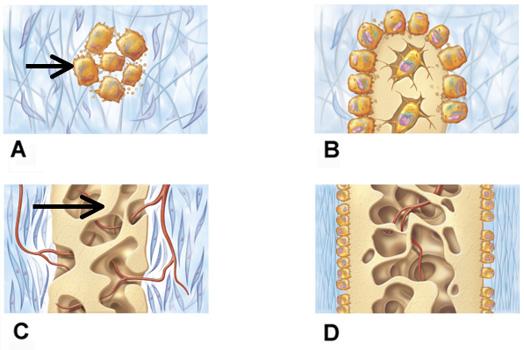 In which step (A-D) does the formation of compact bone first occur?
| back 10 D |
front 11 Why, or why not, is swimming recommended as an exercise to prevent osteoporosis?
| back 11 Swimming is not recommended to prevent osteoporosis, as it is not considered a weight-bearing exercise. |
front 12 What is the structural unit of compact bone?
| back 12 the osteon |
front 13 Which bone cells form bone?
| back 13 osteoblasts |
front 14 Which hormone increases osteoclast activity to release more calcium ions into the bloodstream?
| back 14 parathyroid hormone |
front 15 The structural unit of compact bone (osteon) resembles the growth rings of a tree trunk.
| back 15 True |
front 16 Cranial bones develop ________.
| back 16 within fibrous membranes |
front 17 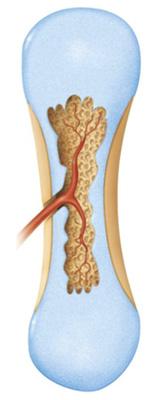 A step in which bone-forming process is shown in the figure?
| back 17 endochondral ossification |
front 18 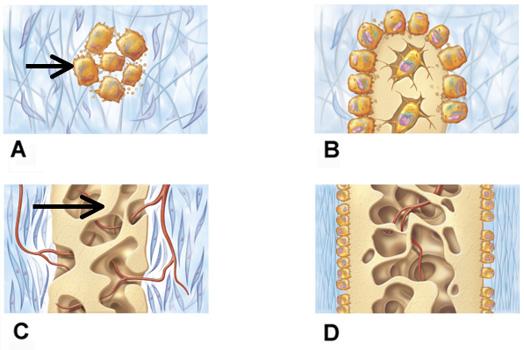 The above figure depicts which of the following bone-forming processes?
| back 18 intramembranous ossification during embryonic development |
front 19 Hematopoiesis refers to the formation of blood cells within the red marrow cavities of certain bones.
| back 19 T |
front 20 For intramembranous ossification to take place, which of the following is necessary?
| back 20 An ossification center forms in the fibrous connective tissue. |
front 21 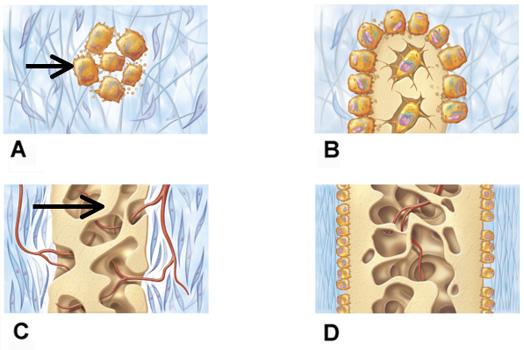 Which of the following substances is NOT a component of the osteoid material secreted by the cells indicated by the arrow in panel A?
| back 21 calcium |
front 22  During bone growth, which significant event occurs at the surface indicated by the letter C?
| back 22 appositional growth |
front 23 Which description of bone cells is INCORRECT?
| back 23 Osteogenic cells can differentiate into osteoclasts. |
front 24 Which of the following glands or organs produces hormones that tend to decrease blood calcium levels?
| back 24 thyroid |
front 25 In some cases the epiphyseal plate of the long bones of children closes too early. What might be the cause?
| back 25 elevated levels of sex hormones |
front 26 The canal that runs through the core of each osteon (the Haversian canal) is the site of ________.
| back 26 blood vessels and nerve fibers |
front 27  In which of the labeled parts of the adult long bone would hematopoietic tissue be located?
| back 27 B |
front 28 Ossification of the ends of long bones ________.
| back 28 is produced by secondary ossification centers |
front 29 The periosteum is a tissue that serves only to protect the bone because it is not supplied with nerves or blood vessels.
| back 29 F |
front 30 Short, irregular, and flat bones have large marrow cavities in order to keep the weight of the bones light.
| back 30 F |
front 31 The hormone that is primarily involved in the control of bone remodeling is the parathyroid hormone.
| back 31 T |
front 32 Which of the following is a bone marking name that indicates an armlike bar of bone?
| back 32 ramus |
front 33 How can a tooth be moved in a bony socket during orthodontic treatment?
| back 33 By applying slight pressure to a tooth, the bone on the forward side will reabsorb, while the bone on the reverse side will be reformed. |
front 34 What tissue forms the model for endochondrial ossification?
| back 34 cartilage |
front 35 Sixty-five percent of the mass of bone is a compound called hydroxyapatite.
| back 35 T |
front 36 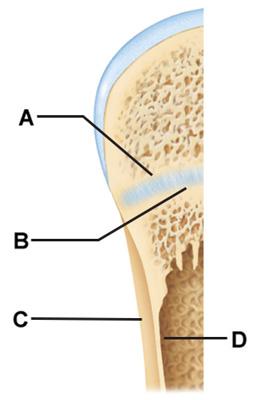 During bone growth, which event is most significant at the surface indicated by the letter A?
| back 36 expansion of the cartilage matrix |
front 37 Which hormone is produced in bone and regulates bone formation, but also protects against diabetes mellitus?
| back 37 osteocalcin |
front 38 Osteomyelitis is ________.
| back 38 due to pus-forming bacteria |
front 39 What controls bone remodeling?
| back 39 mechanical stress and hormones |
front 40 The suture that connects the two parietal bones together is the ________.
| back 40 sagittal |
front 41 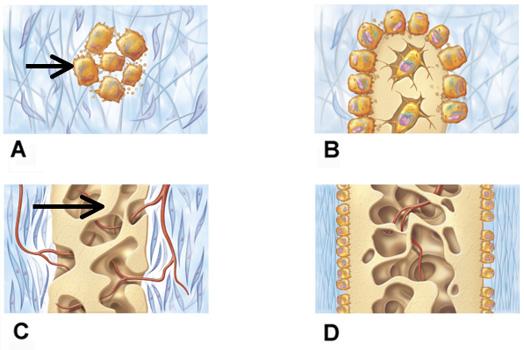 What bone-associated structure in panel C is indicated by the arrow?
| back 41 trabeculae |
front 42 A Pott's fracture could result in damage to all of the following except ____________.
| back 42 tibial condyle |
front 43 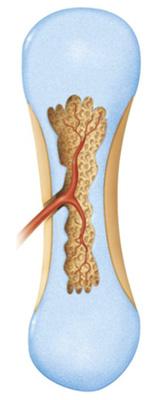 What event precedes the step in the bone-forming process shown in the figure?
| back 43 calcification of the cartilage matrix |
front 44 In newborn infants, the medullary cavity and all areas of spongy bone contain yellow bone marrow.
| back 44 F |
front 45 The correct order (from start to finish) of fracture repair is ________.
| back 45 hematoma formation, fibrocartilaginous callus formation, bony callus formation, and bone remodeling |
front 46 Yellow bone marrow contains a large percentage of ________.
| back 46 fat |
front 47 Hematopoiesis is a term for which of the following physiological processes?
| back 47 blood cell formation |
front 48 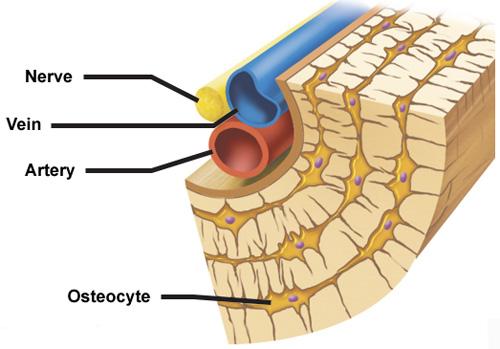 Osteocytes are connected to each other through which structure?
| back 48 caniculi |
front 49 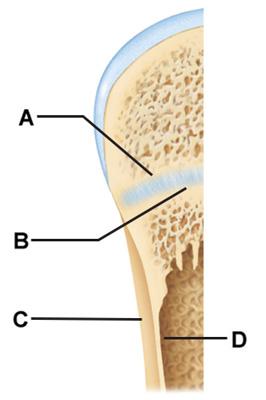 During bone growth, which event is most significant at the surface indicated by the letter B?
| back 49 calcification of the cartilage matrix |
front 50 Choose the TRUE statement.
| back 50 Endochondral ossification converts hyaline cartilage "bone" models into true bones (i.e., hyaline cartilage serves as a template for bone formation). |
front 51 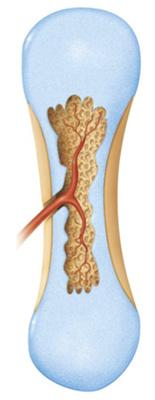 Which of the following bones are formed by the illustrated process?
| back 51 All of the listed responses are correct. |
front 52 The term osteoid refers to the organic part of the matrix of compact bones.
| back 52 T |
front 53 There are seven cervical, twelve thoracic, and five lumbar vertebrae.
| back 53 T |
front 54 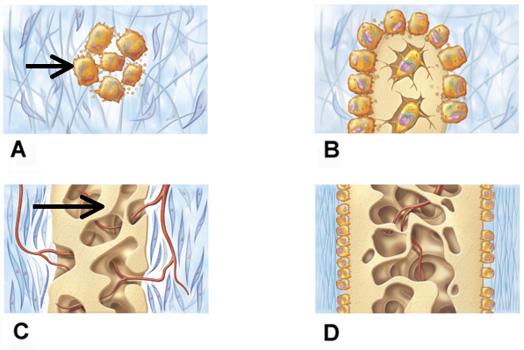 The illustrated bone-forming process would be associated with which of the following bones?
| back 54 parietal |
front 55 Hyaline cartilage ________.
| back 55 is found on the ends of bones that form movable joints |
front 56 Which bone acts as a moveable base for the tongue?
| back 56 hyoid bone |
front 57 Bones are covered and lined by a protective tissue called periosteum. The inner (osteogenic) layer consists primarily of ________.
| back 57 osteoblasts and osteoclasts |
front 58 The structure of bone tissue suits the function. Which of the following bone tissues is adapted to support weight and withstand tension stress?
| back 58 Compact bone |
front 59 During infancy and childhood, the most important stimulus of epiphyseal plate activity is ________.
| back 59 growth hormone |
front 60 In the epiphyseal plate, cartilage grows ________.
| back 60 by pushing the epiphysis away from the diaphysis |
front 61 Which of the following is not a function of the skeletal system?
| back 61 Communication |
front 62 The resilience of bone is primarily due to which of the following?
| back 62 sacrificial bonds in or between collagen molecules |
front 63 The dens articulates with the axis.
| back 63 F |
front 64 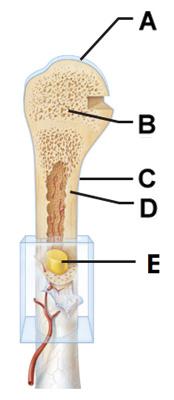 Which of the following is the major component of the part of the bone labeled E?
| back 64 adipose tissue |
front 65 What is the final stage in the healing of a bone fracture?
| back 65 bone remodeling |
front 66 Each consecutive bone lamella has collagen fibers that wrap in alternating directions.
| back 66 T |
front 67 Lengthwise, long bone growth during infancy and youth is exclusively through ________.
| back 67 interstitial growth of the epiphyseal plates |
front 68 Which of the following is not a movement that can occur between vertebrae?
| back 68 supination |
front 69 Closure of the epiphyseal plate stops all bone growth.
| back 69 F |
front 70 Which of the following is an abnormal lateral curvature of the vertebral column often seen in the thoracic region?
| back 70 scoliosis |
front 71 What makes up the axial skeleton?
| back 71 the skull, vertebral column, and rib cage |
front 72 Which of the following is true about paranasal sinuses?
| back 72 Paranasal sinuses enhance the resonance of the voice and lighten the skull. |
front 73 The main role of the appendicular skeleton is to protect and support vital organs.
| back 73 F |
front 74 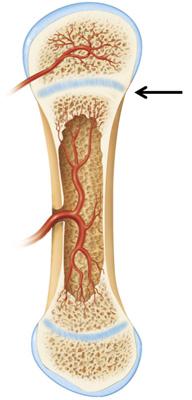 The arrow in the figure is pointing to which of the following structures?
| back 74 the epiphyseal plate |
front 75 What causes osteoporosis?
| back 75 Osteoclasts out-pace osteoblasts due to low hormone production of the ovaries. |
front 76 When chondrocytes in lacunae divide and form new matrix, it leads to an expansion of the cartilage tissue from within. This process is called ________.
| back 76 interstitial growth |
front 77 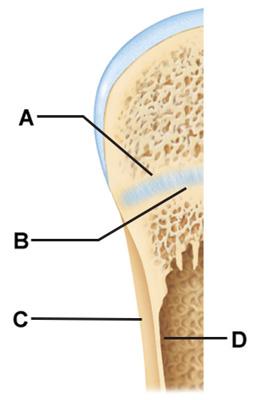 During bone growth, which significant event occurs at the surface indicated by the letter D?
| back 77 bone resorption |
front 78 Which of the following refers to a bone disorder found most often in the aged and resulting in the bones becoming porous and light?
| back 78 osteoporosis |
front 79 Which of the following phrases best describes the function of the vertebral curves?
| back 79 to provide resilience and flexibility |
front 80 Mastoiditis is most likely to result from an infection spreading from the throat.
| back 80 T |
front 81 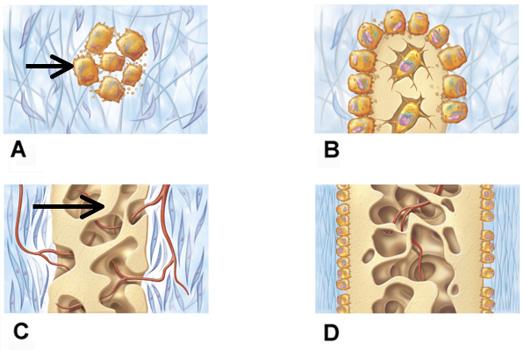 The cells indicated by the arrow at the center of panel A arise from the differentiation of which precursor stem cell?
| back 81 mesenchymal cells |
front 82 Cartilage has a flexible matrix that can accommodate mitosis of chondrocytes.
| back 82 T |
front 83 What type of bone is the patella?
| back 83 sesamoid bone |
front 84 Choose the CORRECT pairing.
| back 84 paget's disease: excessive and haphazard bone deposition and resorption |
front 85 Compact bone is replaced more often than spongy bone.
| back 85 F |
front 86 What is endochondral ossification?
| back 86 the formation of bone from pre-existing hyaline cartilage models |
front 87 Mrs. Mulligan goes to her dentist and, after having a couple of cavities filled, her dentist strongly suggests that she reduce her intake of sodas and increase her intake of calcium phosphates in the foods she eats. Why?
| back 87 Sodas are strong acids that can dissolve the calcium phosphate in bone and teeth. |
front 88 Which structure allows the diaphysis of the bone to increase in length until early childhood, as well as shaping the articular surfaces?
| back 88 epiphyseal plate |
front 89 What is absolutely required for bone growth or healing from a fracture?
| back 89 osteoblasts |
front 90 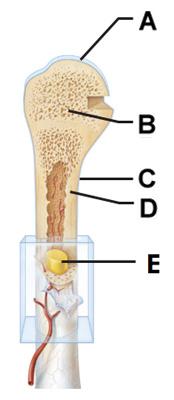 Dense connective tissue forms part of which labeled part of the adult long bone in the figure?
| back 90 C |
front 91 Choose the FALSE statement.
| back 91 Long bones include all limb bones except the patella. |
front 92 Wolff's law is concerned with ________.
| back 92 the thickness and shape of a bone being dependent on stresses placed upon it |
front 93 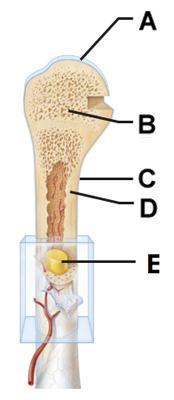 Which of the labeled parts of the bone is composed primarily of compact bone?
| back 93 D |
front 94 Which of the following is UNLIKELY to affect bone remodeling?
| back 94 glucagon |
front 95 The process of bones increasing in width is known as ________.
| back 95 appositional growth |
front 96 An osteon contains osteocytes, lamellae, and a central canal, and is found in compact bone only.
| back 96 T |
front 97 Bones are classified by whether they are weight bearing or protective in function.
| back 97 F |
front 98 A fracture in the shaft of a bone would be a break in the ________.
| back 98 diaphysis |
front 99 The periosteum is secured to the underlying bone by dense connective tissue called ________.
| back 99 perforating (Sharpey's) fibers |
front 100 Alice and James adopted a 3-year-old child from a developing country. They noticed that her legs were bowed and there were some deformities in her cranial and pelvic bones. They brought her to a physician for a diagnosis. What was the diagnosis, and what was the treatment for the disorder?
| back 100 The child most likely has rickets. Treatment is to increase the intake of calcium and vitamin D in the diet, and to get some sunshine every day. |
front 101 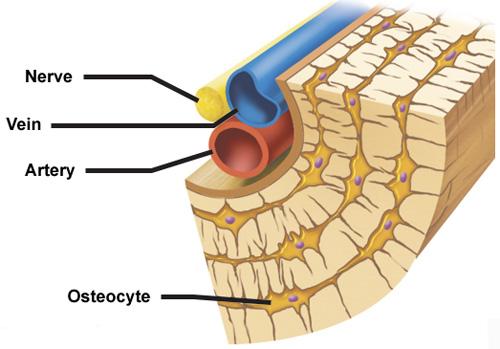 The structures in the figure collectively form a structural unit termed a(n) ______.
| back 101 osteon |
front 102 Osteogenesis is the process of ________.
| back 102 bone formation |
front 103 Which of the following hormones is currently thought to decrease plasma calcium levels in pregnant women and children?
| back 103 calcitonin |
front 104 PTH promotes the formation of which hormone?
| back 104 calcitriol |
front 105 Which of the following would NOT be a way that parathyroid hormone (PTH) could alter plasma calcium levels? (Which one of the following is FALSE?)
| back 105 increase osteoblasts on bone |
front 106 Which hormone works directly in the intestine to increase plasma calcium levels?
| back 106 calcitriol |
front 107 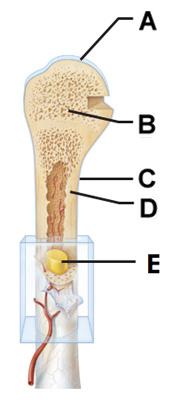 Which of the labeled parts of the bone is composed primarily of hyaline cartilage?
| back 107 A |
front 108 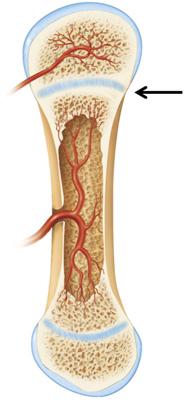 A step in what bone forming process is shown in the figure?
| back 108 endochondral ossification |
front 109 Bones do NOT have a role in ________.
| back 109 glycogen production |
front 110 The membranous areas between the cranial bones of the fetal skull are called ________.
| back 110 fontanelles |
front 111 What is osteoid?
| back 111 the organic part of the matrix of bone |
front 112 The cell responsible for secreting the matrix of bone is the ________.
| back 112 osteoblast |
front 113 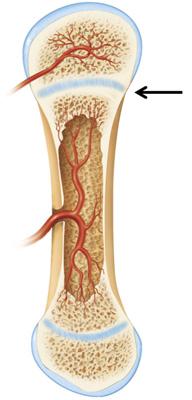 The structure indicated by the arrow is composed primarily of what material?
| back 113 hyaline cartilage |
front 114 What can a deficiency of growth hormone during bone formation cause?
| back 114 decreased proliferation of the epiphyseal plate cartilage |
front 115 Flat bones consist of compact bone sandwiched between spongy bone.
| back 115 F |
front 116 All bones stop growing by the end of adolescence.
| back 116 F |
front 117  What part of the femur articulates (joints) with the patella? Select from letters A-D. | back 117 D |
front 118 Which type of cartilage covers and protects the ends of bones at freely moveable joints?
| back 118 hyaline cartilage |
front 119 What indicates that a long bone has reached its adult length?
| back 119 closure of the epiphyseal plate |
front 120 Hypercalcemia can be caused by_________.
| back 120 hypersecretion of parathyroid hormone |
front 121 Osteoclasts ________.
| back 121 break down bone |
front 122 What kind of tissue is the forerunner of long bones in the embryo?
| back 122 hyaline cartilage |
front 123 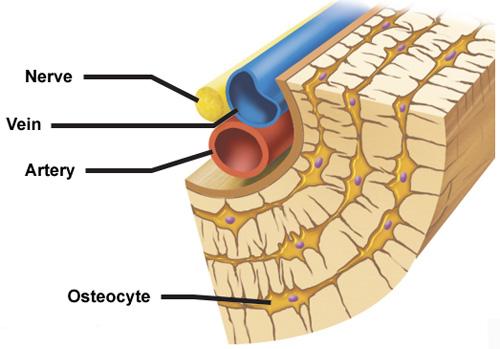 The indicated osteocyte is located within layers of bony matrix termed ______.
| back 123 lamellae |
front 124 Which of the following is stored in bones?
| back 124 phosphate |
front 125 Which of the following is a bone projection?
| back 125 trochanter |
front 126 The trabeculae of spongy bone are oriented toward lines of stress.
| back 126 T |
front 127 The structural unit of spongy is called ________.
| back 127 trabeculae |
front 128 Which of the following statements best describes interstitial growth?
| back 128 Chondrocytes in the lacunae divide and secrete matrix, allowing the cartilage to grow from within. |
front 129 Which bone serves as an enclosure for the pituitary gland?
| back 129 sphenoid bone |
front 130 Growth of bones is controlled by a symphony of hormones. Which hormone is of greatest importance for bone growth during infancy and childhood?
| back 130 growth hormone |
front 131 In adults, hematopoietic tissue is NOT found in ________.
| back 131 the medullary cavity of long bones |
front 132 What is the structural unit of compact bone?
| back 132 osteon |
front 133 Which of the following is the single most important stimulus for epiphyseal plate activity during infancy and childhood?
| back 133 growth hormone |
front 134 The epiphyseal plate is ________.
| back 134 where long bone lengthening occurs |
front 135 Which of the following is CORRECTLY matched?
| back 135 compound fracture: the fractured bone ends penetrate the skin |
front 136 Normal bone formation and growth are dependent on the adequate intake of ________.
| back 136 calcium, phosphate, and vitamin D |
front 137 Which of the following bones is a part of the appendicular skeleton?
| back 137 humerus |